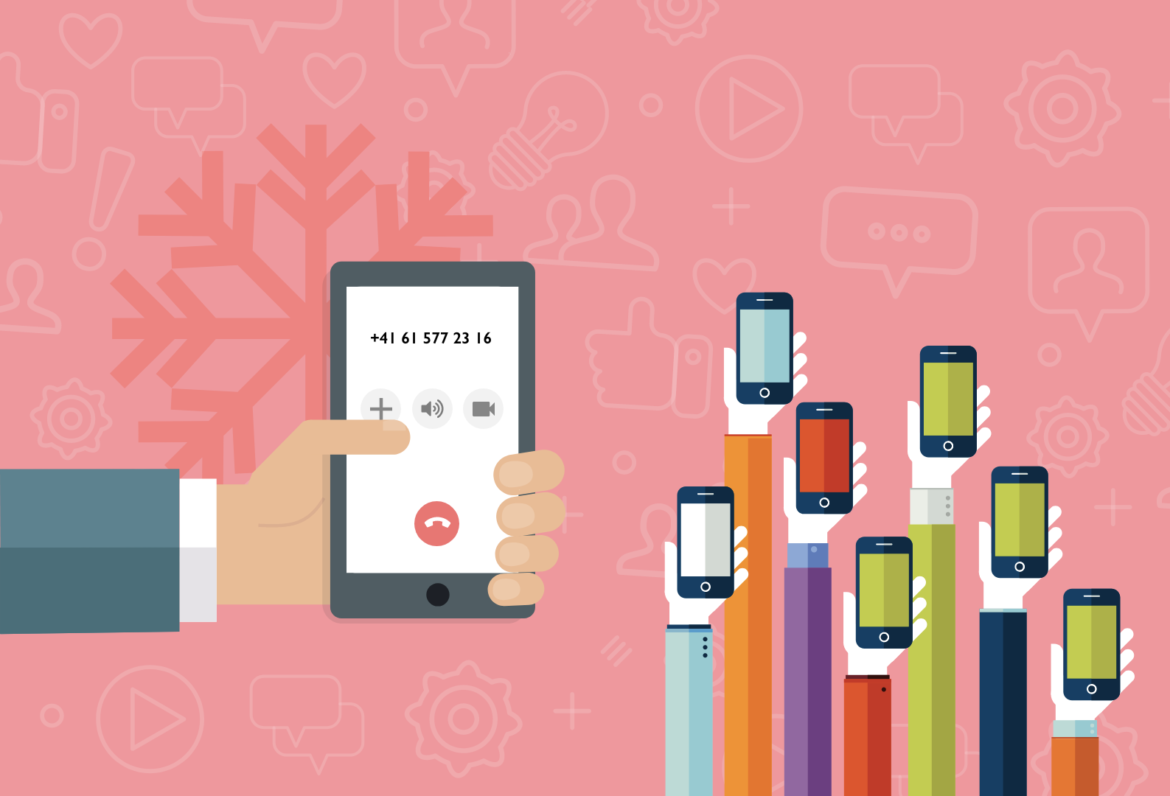Cold calling is hard. But it’s also one of the cheapest and most lucrative ways to get new business.
Entrepreneurs who aren’t trained in sales often struggle to make cold calling work.
When you do it wrong, your prospects will hang up on you without hearing what you have to offer. They miss out on a potentially good solution to a challenge they’re facing.
You can’t always close the sale, but you should always aim to make your pitch.
Here are 10 cold calling sales tips you can implement immediately to glue your prospects to the phone.
1. Make as many cold calls as you can.
“How many cold calls should I make a day?”
This is one of the most frequently asked questions by entrepreneurs.
The answer is: as many as you can — as long as you can maintain quality.
Don’t try to make a fixed number of phone calls a day. Start with the first call and then aim for one more top-quality call. Then for another. And another.
It’s the most natural way of cold calling. Entrepreneurs aiming to make 100 calls might still dial by 10 PM on a week-night. Entrepreneurs aiming for one more top-quality call know that they’re just a bother to their prospects in the evening.
If you aren’t on top of your game, don’t burn through your prospect list just to hit a number-based goal.
2. Regret is worse than rejection.
In our interview about the best cold calling opening line, Jack Vincent, author of A Sale is a Love Affair, touched on the fear of rejection.
Jack is talking.
“One thing that holds people back from cold calling is their fear of rejection. Fear of rejection is primal and making a cold call is the easiest way to get rejected. It hurts. But only for a very short time. What hurts more and longer than rejection is regret. Imagine you don’t make a cold call, and a month later you read that your competitor is working for that prospect.”
Get rejected and be done with it. Don’t punish yourself with the what-if.
3. 7% is about what you say, and 93% is about how you say it.
Communication isn’t just about what you say. It’s mostly about how you say it. Studies have found that in face-to-face conversations, your communication is 93% non-verbal. That 93% are split between body language and tonality.
Because people can’t read your body language over the phone, your tonality matters even more. Talk naturally, as you would with a friend in a bar.
Quick tip: Smile when you’re talking on the phone. Smiling changes your voice. It makes you sound happier and in turn, lightens your prospect’s mood.
4. Listen twice as much as you talk.
This goes for every sales conversation. Not just because people like to talk about themselves, but also because you get valuable information by listening.
You’ll learn what problems your prospect is facing, what solutions they have tried, and what they are looking for next.
Based on what you’ve learned by listening, you can tailor your pitch to their situation.
Quick tip: Ask open-ended questions. Those are questions that your prospect can’t answer with yes or no. Start your questions with why, how, what, etc.
5. Have a cold call script (but don’t let it show).
Imagine the following scenario.
You’re on the line with a sales rep. They sound as if they are following the words with their finger. You ask a question and hear sheets being shuffled around, and the sales rep makes “ehhm” and “hmm” for a few seconds. Then you get a generic answer that doesn’t help your situation whatsoever.
Would you want to do business with them? I wouldn’t.
Having a script is important because it’s easy to run out of things to say. But you can’t sound as if you’re reading from one. Keep it human. You wouldn’t bring a script to a dinner with friends, would you?
6. Do your homework on your prospects.
Preparation is the key to success.
Let me hammer this point home with a story about Jordan Belfort, The Wolf of Wallstreet.
Jordan was asked to participate in an experiment. He was supposed to sell something to a prospect. Jordan didn’t know that the prospect was told not to agree to a deal under any circumstance.
Jordan had a standard amount of time to prepare but could request additional time if needed. He roughly needed four times as long to prepare than initially planned.
In the end, the prospect gave up and told the examiner that he couldn’t refuse the deal anymore. Jordan knew his every desire, problem, and objection and sold the offer as if it was made for the prospect.
You don’t need to spend those hours on every prospect. But take a minute or two before each call and make notes. Skim their social media profiles to find out what their desires are and what challenges they are facing. Some conversation starters are helpful as well, like a shared hobby or having the same hometown.
Quick tip: It’s awkward if you call someone and can’t pronounce their name. Find out how to pronounce it before you’re on the line.
7. It’s about trust, not about your product.
Don’t double-time through your sales pitch the second your prospect picks up. Introduce yourself calmly and make conversation. Be natural and be human. Tell your prospect you’re calling to help and if they’re interested, tell them what you’re offering.
In some articles, you’ll read that it’s a great strategy not to mention your reason for calling upfront. Your prospect might think you’re a friend or a customer.
If you start off that way and then turn the conversation from friendly chatter to your sales pitch, your prospect will feel duped. You can hardly build trust after this first impression.
8. Don’t sell features. Sell benefits.
Beginners often sell features instead of benefits. “Our product has the longest life-span in the market.” “Our software saves you three hours of work a week.” “We have a 3-year warranty.”
Those are all good features. But they don’t sell. Benefits do.
Apple has proven this point with how they sold the first iPod. Nobody asked for a device like that, yet everybody bought it.
Apple didn’t say: Our iPod has 1GB of storage for mp3 files!
Apple said: With our iPod, you have 1000 songs in your pocket.
The storage size was an impressive feature at that time. But having that (back then incredible) amount of music in your pocket triggered an emotional response.
We know that many entrepreneurs struggle to make the right connections to investors, business partners, and capable employees.
We don’t say: We have more than 7800 square meters of coworking space with lightning-fast wifi and free coffee.
We say: In our coworking space, you connect with people that matter to your startup.
You know what your prospect needs. You’ve done your homework. Figure out how your product fulfills those needs. Then you’re selling the benefit.
9. Know common objections and how to deal with them.
Rarely will someone just take your offer on the spot. Usually, you’ll hear objections like: “I need to sleep on it,” “I have to ask my colleague,” or “I’d buy it, but I’m short on cash.”
Before you make any calls, think about what objections your prospects could have. Write them down, one below the other. I’ll show you a five-step framework to deal with any objection coming your way:
- Acknowledge the objection. Thank your prospect for sharing their concern and validate them. Don’t say “yes” or “no” or — the worst of all — “yes, but…” Just say “Thanks for bringing that up. You raise a valid point here.”
- Make a statement against their objection. Say one sentence to negate their objection. For example, if someone is low on cash, say: “We want everyone to be able to afford our product.”
- Back up your statement. Now you have to prove to your prospect that you aren’t just saying whatever you can to make them buy. Following the previous example, you could say: “We have various payment programs. One of those surely fits your needs.”
- Link a benefit. We don’t sell with features. We sell with benefits. After suggesting your various payment programs, you could say: “You’ll be able to enjoy [insert product benefit] paying just [insert amount] a month.
- Seek validation. Ask your prospect if everything’s good now or if they have any more concerns. If they answer with: “Yes, all good now,” you can ask them to close the sale. If they have more objections, start at step one.
10. Always be closing.
Did that headline make you think about that sleazy salesman from the car dealership?
I’m not saying you should always get the sale. You can’t. But you shouldn’t hang up the phone without getting any result at all.
Sometimes that result is scheduling the next call. Sometimes it’s getting the contact info of their supervisor.
Not everyone will need your product. There will be prospects that will thank you for calling and tell you that they don’t need your product because they already overcame their challenge. No problem!
Simply say: “Before we hang up, do you know someone else who might be up against this challenge?”
If you’re struggling with finding new customers, read our definite guide to finding new customers.



